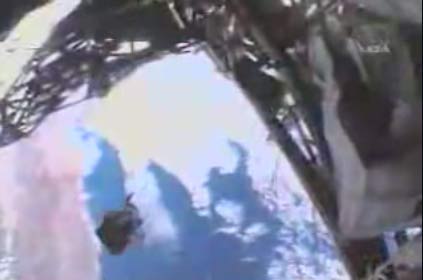Backyard Skywatchers Find Tool Bag Lost in Space

Amateurastronomers have been monitoring a shiny tool bag that has been orbiting Earthever since it was dropped last week by an astronaut during a spacewalk outsidethe International Space Station.
The bag is reportedlyabout magnitude 6.4, which under most sky conditions is too faint to see withthe naked eye.
Veteranspacewalker and Endeavor astronaut Heide Stefanyshyn-Piper losther grip on the backpack-sized bag on Nov. 18 while cleaning up a mess froma leaking grease gun she was carrying to help mop up metal grit from inside amassive gear that turns the space station's starboard solar wings.
The toolbag cost $100,000 and its loss meant astronauts had to share the remaining toolbag for subsequent spacewalks. The tool bag weighs about 30 pounds (14 kg) andis 20 inches (51 cm) wide, about a foot (30 cm) tall and a hand's-width deep,according to John Ray, STS-126 lead spacewalk officer for the flight. The bagcontained two grease guns, a scraper tool, a large trash bag and a small debrisbag.
Once the toolbag floated away, some thought they'd seen the end of it. Not quite. Asatellite tracker at Spaceweather.comnow is monitoring both the spacestation and the tool bag.
Aftersunset on Nov. 22, Edward Light, using 10 x 50 binoculars, spotted the bag inspace while he scanned the sky from his backyard in Lakewood, N.J.,Spaceweather.com reported. On the same night, Keven Fetter of Brockville, Ontario, video-recorded the bag as it passed by the star Eta Pisces in the constellationPisces.
Morebag-viewing opportunities are expected.
Get the Space.com Newsletter
Breaking space news, the latest updates on rocket launches, skywatching events and more!
The toolbag can be seen through binoculars, a few minutes ahead of the space station'sorbit. The satellite tracker predicts that the bag will be visible throughbinoculars from Europe and western North America during a series of passes thisweek. By late next week, the tool bag should appear in the evening skies overmost of North America.
Like otherspace debris, the tool bag's show will have a fiery end. "We currentlypredict that the errant tool bag will fall back to Earth in June of next year,"said Nicholas Johnson, chief scientist for orbital debris at NASA's Johnson Space Center in Houston. "The date is dependent upon solar activity, so an earlieror later date is possible. As the reentry date draws nearer, a more accurateprediction can be made."
And heexpects the entire tool bag will burn up upon reentry. "Although we havenot yet conducted a detailed reentry survivability analysis for the tool bagand its contents, it is highly likely that no components will reach the surfaceof the Earth," Johnson told SPACE.com.
The tool bagis not the only piece of spacetrash from the station. Other junk includes an unmanned Russian cargo shipand a massive ammonia coolant tank the size of a refrigerator. The coolant tankwas intentionally tossed from the space station in 2007, and it burned up inEarth's atmosphere earlier this month. The cargo ship undocked on Nov. 14, butwill loiter in orbit for engineering tests before its planned disposal inEarth's atmosphere in early December.
- 10 Most Memorable Pieces of Space Debris
- Quiz - How Astronauts Live in Earth Orbit
- Video - The Fiery Demise of Europe's Jules Verne Spaceship
Join our Space Forums to keep talking space on the latest missions, night sky and more! And if you have a news tip, correction or comment, let us know at: community@space.com.










